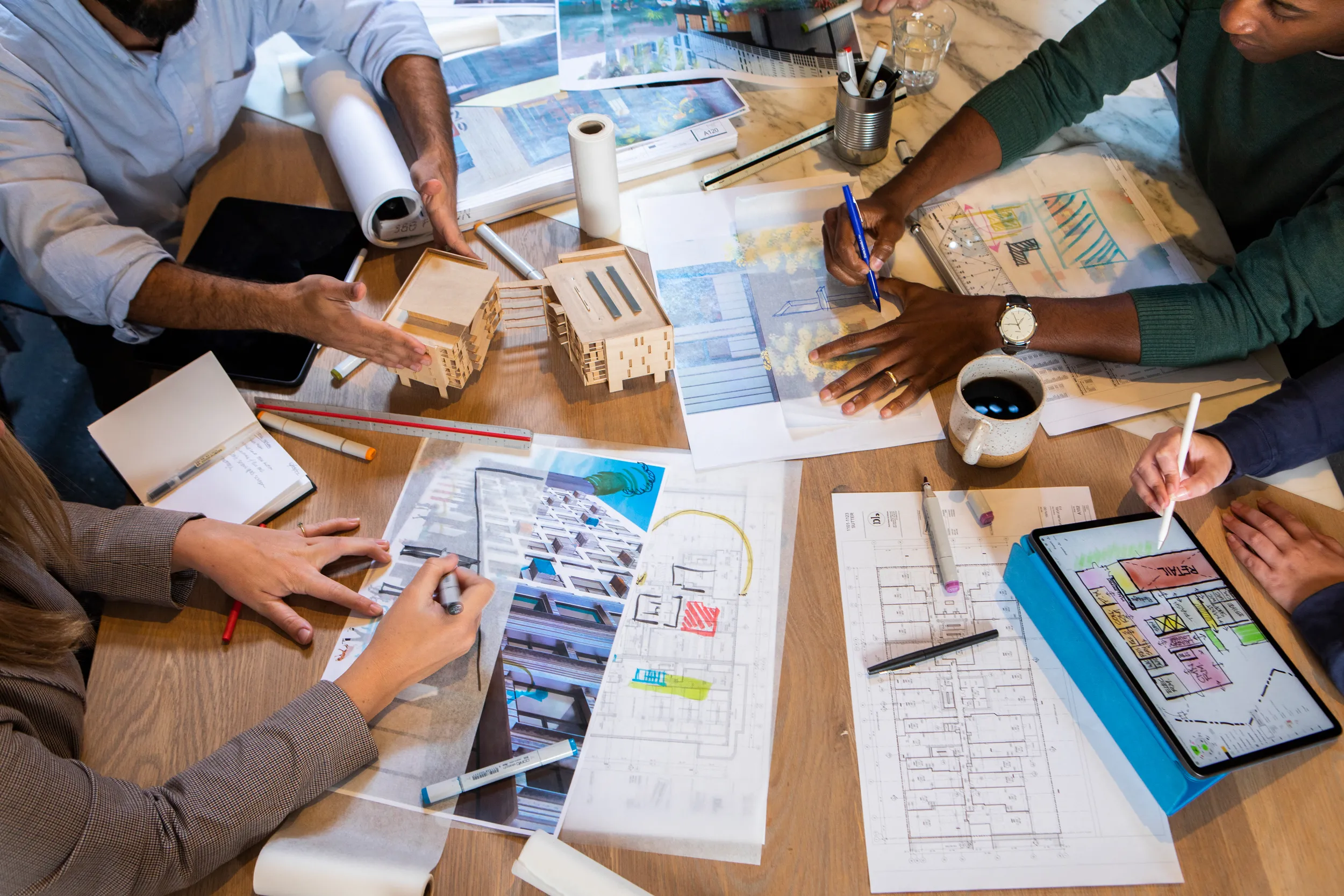Recognizing the Diverse Profession Paths Available for Aspiring Architect
As a hopeful Architect, you have a globe of occupation courses waiting for you. Each course offers unique challenges and chances to apply your creativity and technical know-how. Whether you're attracted to standard architecture or the nuances of sustainable style, there's a specific niche that aligns with your passions. Recognizing these varied options can shape your professional trip, however which instructions will you select to discover first?
Traditional Design: Creating Structures and structures
Traditional design focuses on creating structures and frameworks that mix performance with visual allure. Your layouts can reflect social heritage, showcasing regional customs while satisfying contemporary requirements.
You'll create abilities in preparing, model-making, and website analysis, allowing you to visualize and communicate your concepts efficiently. Engaging with clients, you'll require to comprehend their vision and equate it right into feasible styles.
Additionally, constructing codes and sustainability methods are crucial in your work, ensuring your structures are eco pleasant and safe. As you grow in your occupation, you'll locate opportunities in property, business, or even reconstruction projects, each offering distinct obstacles. Welcoming typical design leads the way for a meeting career that admires the past while shaping the future.
Urban Preparation: Forming Neighborhoods and Public Spaces
As an ambitious Architect, you can play a crucial role as an urban planner, changing just how neighborhoods interact and function. By using area engagement approaches, you'll ensure that homeowners have a voice in forming their setting. Plus, incorporating sustainable design principles will assist create areas that not only satisfy today's requirements however likewise protect the future.
Function of Urban Planners
While numerous could think about engineers as the sole visionaries behind structures, metropolitan planners play an essential duty fit the more comprehensive landscape of communities and public spaces. They examine land usage, zoning legislations, and neighborhood requires to create sustainable atmospheres that enhance high quality of life. By collaborating with different stakeholders, you'll aid make parks, transportation systems, and houses that advertise social interaction and access. Urban coordinators likewise concentrate on ecological considerations, guaranteeing that developments integrate green spaces and support biodiversity. Your knowledge in spatial design and area characteristics allows you to imagine future development while preserving social heritage. In this crucial role, you'll straight affect exactly how people experience their environments, making every job a possibility for favorable adjustment.
Neighborhood Involvement Approaches
Reliable community involvement techniques are vital for metropolitan organizers to guarantee that the voices of residents are listened to and valued in the preparation process. To promote purposeful discussion, you ought to focus on open forums and workshops where area participants can share their ideas and worries. By actively listening and including responses, you'll produce rooms that mirror the area's needs, eventually leading to more successful and lasting metropolitan environments.
Sustainable Design Concepts
When developing urban areas, including lasting style principles is crucial for producing atmospheres that prosper both ecologically and socially. You ought to begin by concentrating on power effectiveness, utilizing materials that decrease waste and promote recycling. Consider integrating environment-friendly rooms, like gardens and parks, to boost biodiversity and boost air high quality. Promoting walkability and public transportation can lessen dependence on cars, fostering a healthier area.
Designing with water preservation in mind is also essential-- think regarding rain yards and permeable surfaces to take care of stormwater. Involving community members throughout the preparation procedure guarantees that the rooms you produce meet their needs and encourage social interaction. By accepting these concepts, you'll add to vivid, lasting urban landscapes that benefit everybody.

Landscape Design: Developing Lasting Outdoor Environments
As you explore landscape design, you'll find necessary design concepts that create practical and gorgeous outside rooms. Sustainable practices play an important duty in making sure these environments flourish while lessening ecological influence. Plus, you'll locate a variety of job possibilities that allow you to make an actual difference in just how people engage with nature.
Design Concepts in Landscape
Understanding style concepts in landscape architecture is necessary for creating lasting outdoor atmospheres that integrate with nature. You'll need to ponder aspects like proportion, balance, and range to assure your designs feel natural and welcoming. Including indigenous plants not just enhances biodiversity however likewise minimizes water usage, making your landscape resistant. Think of the flow of space and exactly how individuals interact with it; pathways and seating locations ought to welcome expedition and leisure. In addition, focus on seasonal modifications, designing with materials that complement the surroundings year-round (Architect). By prioritizing sustainability and aesthetics, you can produce exterior rooms that improve the area and advertise well-being. Accepting these principles will set a strong foundation for your profession in landscape style.
Lasting Practices Review
Sustainable methods in landscape architecture not only focus on aesthetics however also prioritize eco-friendly health and wellness and source conservation. You can design areas that advertise dirt health, such as practicing and making use of natural products permaculture concepts. Ultimately, these methods ensure your layouts benefit both people and the atmosphere for years to come.
Occupation Opportunities Expedition
With a solid structure in sustainable practices, landscape design provides a selection of job paths that permit you to make a significant influence on the environment. You could work as a landscape designer, producing visually pleasing and practical exterior spaces, or specialize in ecological remediation, assisting to restore broken ecological communities. Urban organizers often collaborate with landscape engineers to develop environment-friendly rooms in city setups, improving city livability. If you're passionate about education, consider becoming a landscape style instructor, inspiring future generations. Additionally, you may deal with nonprofits concentrated on environmental sustainability or participate in research study to innovate brand-new techniques. Each path not just forms lovely settings however also cultivates a much healthier world for future generations.
Lasting Design: Concentrating on Eco-Friendly Practices
As you discover your job in design, welcoming environment-friendly practices can set you apart in an affordable field. Lasting layout concentrates on developing buildings that minimize environmental influence while enhancing passenger health. By integrating eco-friendly materials, energy-efficient systems, and lasting structure techniques, you'll contribute to a greener future.
Beginning by getting knowledge of eco-friendly qualifications like LEED or BREEAM, which can bolster your credentials. Take into consideration how natural light, ventilation, and thermal effectiveness can enhance style. Collaborate with designers and ecological professionals to innovate services that decrease waste and preserve sources.
Don't forget the significance of neighborhood participation-- appealing neighborhood stakeholders can influence designs that integrate with the atmosphere. As clients progressively prioritize sustainability, your expertise in environment-friendly methods will certainly not only attract projects but also satisfy your enthusiasm for liable style. Welcome this critical facet of the career, and see your career flourish.
Historic Conservation: Shielding and Recovering Social Heritage
While you commence on your building trip, think about the vital function of historical conservation in preserving our cultural heritage. This area focuses on the defense and remediation of considerable buildings, sites, and frameworks that inform the stories of our past. By taking part in historic conservation, you'll assist protect the architectural heritage that shapes neighborhood identity.
As a historical preservation Architect, you'll analyze historic importance and analyze the problem of structures. You'll function carefully with conservationists and chroniclers to guarantee genuine repair techniques are used. This profession course allows you to mix imagination with research, here are the findings allowing you to design options that respect original products and craftsmanship.
Your job not only contributes to sustainability by recycling existing buildings however also promotes a feeling of pride within neighborhoods. Embracing this path will certainly help you end up being a guardian of background, preserving the stories and visual appeals that improve our lives.
Interior Design: Enhancing Indoor Spaces
Historical preservation and interior design both share a dedication to enhancing the built setting, however they concentrate on different elements. While historical conservation emphasizes preserving a framework's historic and social worth, indoor style zeroes in on enhancing interior rooms for functionality and looks.
As an aspiring Architect, you'll discover that indoor architecture enables you to blend imagination with technological abilities. You'll design rooms that not only look excellent yet additionally promote convenience and efficiency. This area includes understanding how light, color, and materials communicate within a room, influencing state of mind and use.
You'll deal with numerous tasks, from domestic homes to industrial offices, making sure that each atmosphere satisfies the needs of its passengers. By focusing on individual experience, you can transform interiors into motivating and functional rooms, making a substantial effect on just how people communicate with their surroundings. Embrace the possibility to boost indoor environments and shape the way people live and function.
Industrial Design: Merging Capability With Visual Appeals
Industrial layout plays a crucial duty in producing products that seamlessly mix appearances with capability, making sure that what you use daily is not only aesthetically appealing yet likewise useful. As an aspiring Architect, you might immerse on your own in this field, concentrating on making everything from furnishings to consumer electronic devices. Your work involves recognizing individual demands, materials, and manufacturing processes, allowing you to produce cutting-edge remedies that improve day-to-day experiences.
In commercial layout, you'll frequently work together with suppliers, marketing professionals, and designers, making certain that your designs are not only beautiful however additionally viable. This profession course supplies a vibrant setting where creativity fulfills functionality, making it a satisfying option for designers interested in shaping the products of tomorrow.
Often Asked Questions
What Educational Accreditations Do I Need to Become an Engineer?
To become an engineer, you'll need a specialist degree in style, normally a Bachelor's or Master's. Furthermore, you'll need to complete a teaching fellowship and pass the Architect Enrollment Examination to exercise legally.
Exist Certification Needs for Various Building Career Paths?
Yes, there're qualification requirements for numerous building paths. Architect. You'll require to pass examinations, complete internships, and often go after specialized training, depending on your picked focus, like landscape style, urban layout, or historic preservation
What Software Program Skills Are Vital for Engineers Today?

Exactly How Can I Gain Practical Experience While Researching Design?
You can gain functional experience by interning at building firms, joining style competitions, offering for area projects, or teaming up with classmates on real-world assignments. These chances improve your skills and construct important connections in the industry.
What Work Opportunities Exist Outside Typical Style Firms?
You can check out numerous task possibilities outside typical architecture firms, like city preparation, interior layout, landscape style, Find Out More construction administration, realty development, or perhaps functions in sustainability consulting. Each offers special obstacles and rewards.
Whether you're drawn to standard architecture or the nuances of lasting layout, there's a particular niche that straightens with your passions.When developing city spaces, incorporating sustainable layout concepts is critical for creating environments that thrive both ecologically and socially.As you check out landscape design, you'll discover go necessary layout concepts that create gorgeous and useful outdoor spaces.Comprehending layout concepts in landscape architecture is important for producing lasting exterior settings that harmonize with nature.In commercial design, you'll typically team up with engineers, manufacturers, and marketing professionals, making certain that your styles are not just stunning yet also viable.